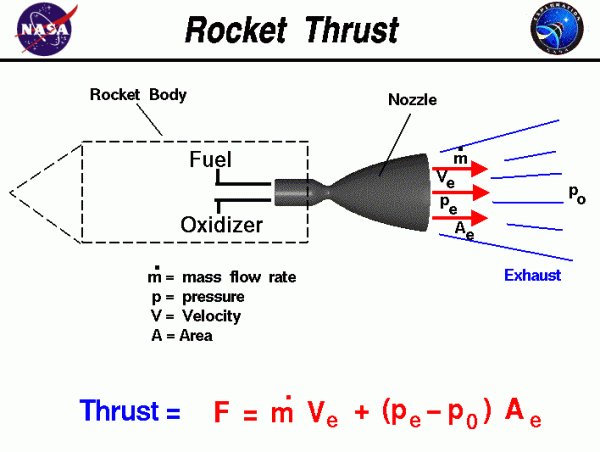Rocket Thrust Equation

Schematic
On this slide, we show a schematic of a rocket engine. In a rocket engine, stored fuel and stored oxidizer are ignited in a combustion chamber. The combustion produces great amounts of exhaust gas at high temperature and pressure. The hot exhaust is passed through a nozzle which accelerates the flow. Thrust is produced according to Newton’s third law of motion.
Amount of Thrust
The amount of thrust produced by the rocket depends on the mass flow rate through the engine, the exit velocity of the exhaust, and the pressure at the nozzle exit. All of these variables depend on the design of the nozzle. The smallest cross-sectional area of the nozzle is called the throat of the nozzle. The hot exhaust flow is choked at the throat, which means that the Mach number is equal to 1.0 in the throat and the mass flow rate \(\dot{m}\) pronounced m dot is determined by the throat area. The area ratio from the throat to the exit Ae sets the exit velocity Ve and the exit pressure pe. You can explore the design and operation of a rocket nozzle with our interactive thrust simulator program which runs on your browser.
Exit Pressure
The exit pressure is only equal to free stream pressure at some design condition. We must, therefore, use the longer version of the generalized thrust equation to describe the thrust of the system. If the free stream pressure is given by p0, the thrust F equation becomes:
Thrust Equation
\(\LARGE F=\dot{m}V_{e}+A_{e}(p_{e}-p_{0})\)
Notice that there is no free stream mass times free stream velocity term in the thrust equation because no external air is brought on board. Since the oxidizer is carried on board the rocket, rockets can generate thrust in a vacuum where there is no other source of oxygen. That’s why a rocket will work in space, where there is no surrounding air, and a gas turbine or propeller will not work. Turbine engines and propellers rely on the atmosphere to provide air as the working fluid for propulsion and oxygen in the air as oxidizer for combustion.
The thrust equation shown above works for both liquid rocket and solid rocket. engines. There is also an efficiency parameter called the specific impulse which works for both types of rockets and greatly simplifies the performance analysis for rockets.
